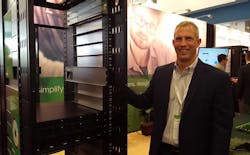Data Centers Without Boundaries: The Challenges of Managing Distributed IT
In a world where data travels everywhere, the world of IT has extended into storefronts, stadiums and smartphones that can bring the Internet into the palm of one’s hand. If you’re in the business of managing data, it’s a big challenge.
Kevin Brown calls this “data centers without boundaries.” Brown, the SVP of EcoStruxure Solutions at Schneider Electric, says the world has changed, and IT managers will require new tools to manage it.
“It’s no longer about resiliency just inside of data centers,” said Brown. “It is about infrastructure everywhere, and how we manage this distributed environment. We believe that’s driving new challenges, and we call that DCIM 3.0.”
DCIM is short for data center infrastructure management, and Schneider this week has rolled out a modernization of its EcoStruxure IT software portfolio to monitor and manage the sprawling, hybrid nature of today’s IT infrastructure. EcoStruxure has been deployed in almost 500,000 sites with the support of 20,000+ developers, 650,000 service providers and partners, 3,000 utilities and connects over 2 million assets under management, according to Schneider.
Many of the updates acknowledge this new world for IT management. In the early days of DCIM, the goal was to deploy sensors to monitor key aspects of the data center environment, especially temperature and energy usage. The idea was to create an instrumented, closely-tracked environment that could be measured and optimized.
The growth of cloud platforms and edge computing has unleashed new services and applications, but also tested the capabilities of software designed for data center environments. sustainability has also emerged as another priority, meaning the carbon footprint of data centers will need to be measured and managed.
“There’s been tremendous change since DCIM first emerged as a software category,” said Brown. “The hybrid IT environment is challenging even the most sophisticated CIO organization with maintaining the resiliency, security, and sustainability of their IT systems.
“This is a new trend that we see hitting the market,” he added. “We’re very early in this trend, and if history is any guide it’s going to be a 20 year cycle.”
Schneider Electric projects that by 2040, the total data center energy consumption will be 2,700 TWh, with 60% coming from distributed sites and 40% from data centers.
“That’s a much different outlook and a much different set of challenges than what you see now,” said Brown. “If everything is now a data center, what are the differences in the challenges that customers are experiencing?
“If you take a look at (IT cabinets) across 2,000 stores, and take a look at the amount of power that’s in there, it’s bigger than the power consumed inside of the data center by a factor of 10,” he said. “All of this needs to be maintained and kept up and running.
“And candidly, we become much more dependent on this infrastructure since the pandemic,” said Brown. “It is no longer optional. It is now business critical that things are running up and running all the time.”
About the Author



